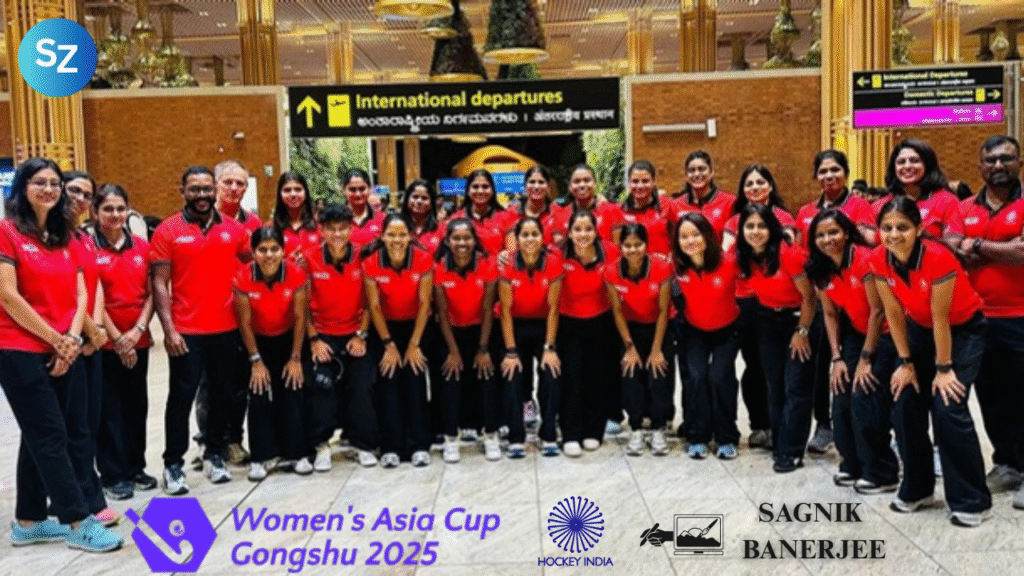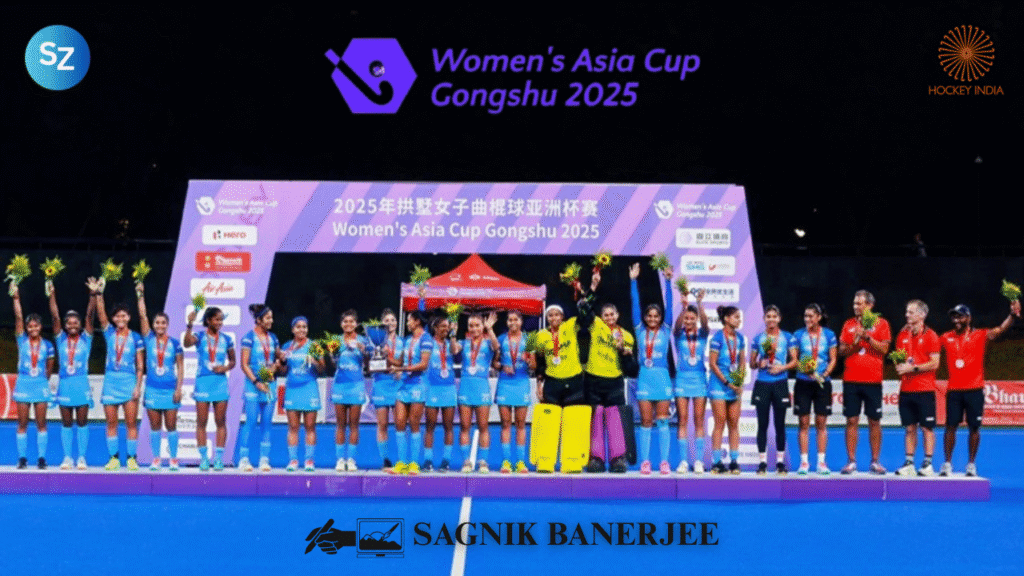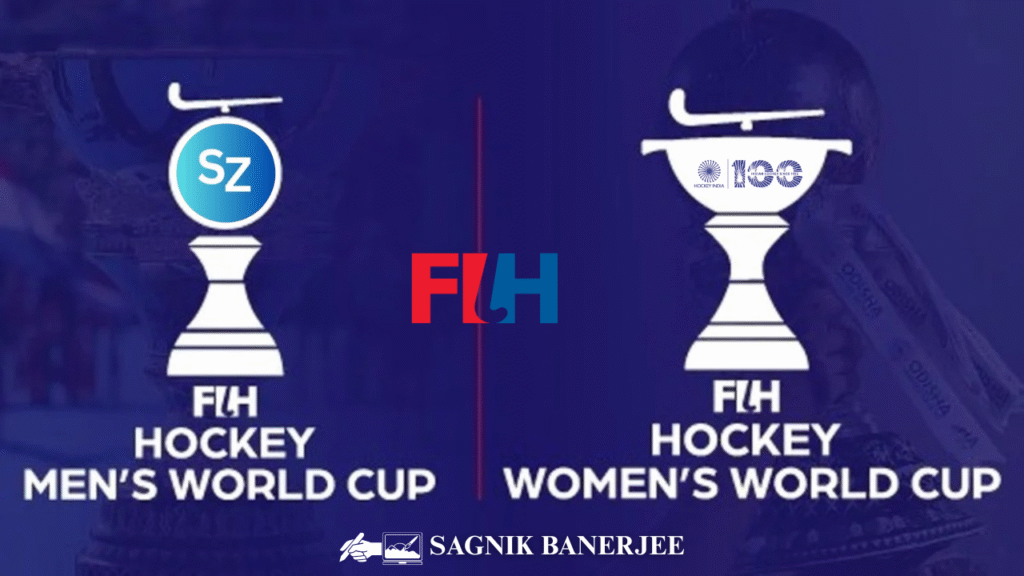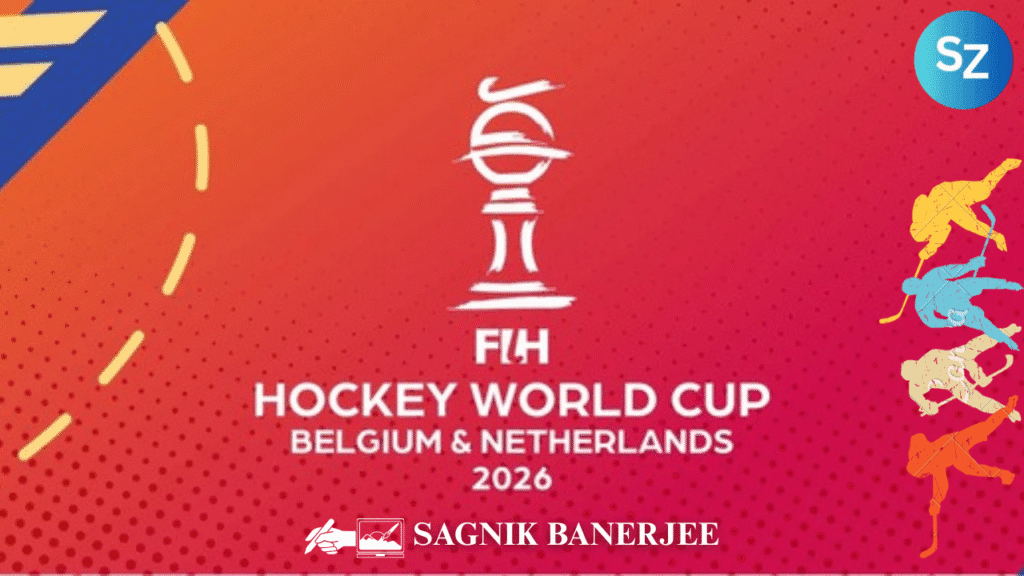The Men’s Asia Cup 2025 was more than just a continental tournament; it was a symbolic homecoming for Indian hockey. Held in Rajgir, Bihar from August 29 to September 7, the competition carried extra weight because it doubled as the Asian qualifier for the 2026 FIH Men’s Hockey World Cup in Belgium and the Netherlands.
India was one of the pre-tournament favourites, not only due to their position and strength, but due to the increasing momentum in Asian hockey, with such countries as Malaysia, Japan and South Korea continually taking India to greater heights.
The group phase revealed the offensive capabilities of India. The men in blue opened against Kazakhstan and were merciless as they registered a 15-0 win that showed how much of a gap there is between the established and the developing nations in the field of hockey.
It wasn’t just a statistic, but the margin of victory also increased the goal difference of India, and this would be crucial in the Super 4s stage. India went against China again and won 6-0 through smooth passing and finishing.
The factual test was however faced with Japan. During a tense match, Japan was able to draw India 2-2 showing some small weaknesses in defense but also highlighting the fact India could stand their nerves despite being under pressure.
India topped Pool A, and it entered the Super 4s with confidence. Here, consistency was key. The format also meant that any lost point had a possibility of influencing the end-result and India had to shoulder the burden well. Those victories demonstrate a defensive and offensive balance, with a 7-0 demolition of China and a 4-1 one against Malaysia.
India, against defending champions South Korea, went with another 2-2 draw, and though fans were slightly tense, the fact that they had a better goal difference (+10) saw them finish on top of the table. This outcome created an appetizing final match against South Korea who were their long time Asian competitors.

Final: India Dethrone South Korea with Clinical 4-1 Win
The Rajgir Hockey Stadium was a cauldron of noise on September 7, 2025, as India and South Korea clashed in the Asia Cup final. The atmosphere was electric, with thousands of fans waving the tricolor and chanting “Bharat Mata Ki Jai.” For India, this was more than a title match, it was a chance to reclaim continental supremacy after years of fluctuating fortunes in Asia.
India had started off with a dream. Sukhjeet Singh, within the first minute tied a through ball and scored a field goal, and the people were in frenzy. The jump-start strike shook South Korea, who are reputed to be a disciplined defensive formation. Feeling exposed, India stressed high and made forced errors. They got what they deserved when Dilpreet Singh scored in the 28th minute with a perfect finish following a fast-moving pass.
The third quarter was the statement of intent for India. As Korea pursued the game, India took advantage of the penalty corners. In the 50th minute, long-serving defender Amit Rohidas pulled off a thunderbolt drag flick that practically ended the match 4-0. The result was not in question and South Korea made one back in the 51st minute through Son Dain.
The characteristic of this final was the Indian strategic performance. The focus of coach Craig Fulton on quick, swift transitioning and harsh penalty corner conversions was ideal. They were under pressure, but the defense led by Harmanpreet Singh and Rohidas managed the situation very well, with the goalkeeper saving the day with timely saves at the right time.
At the end of the game, the score was in favour of India with 4 goals to 1 goal for South Korea, which not only gave India the title of the Asia Cup but also a direct ticket to the 2026 FIH World Cup. It was a reward to the players and vindication of the hockey revival in India to the fans.

Men’s Asia Cup: Final Standings and Awards
The Asia Cup 2025 concluded with India at the pinnacle, but the tournament was rich with storylines from other teams as well. South Korea, though beaten in the final, reaffirmed their position as a resilient force in Asian hockey. Malaysia impressed with attacking flair, while China showed glimpses of progress but lacked consistency.
Final Standings:
- India – Champions
- South Korea – Runners-up
- Malaysia – Third Place
- China – Fourth Place
The awards reflected individual brilliance:
- Best Player: Abhishek Nain (India) – His dynamic playmaking and versatility in midfield made him indispensable.
- Best Goalkeeper: Kim Jae-hyeon (South Korea) – Despite conceding in the final, his reflexes and shot-stopping throughout the tournament were outstanding.
- Best Young Player: Andy Jefferyan (Malaysia) – A revelation in attack, he terrorized defenses with pace and creativity.
- Top Scorer: Akhimullah Anuar (Malaysia) – His tally of 12 goals highlighted Malaysia’s attacking intent.
The men’s tournament saw a total of 164 goals, averaging 6.83 per game. This high scoring rate was evidence of Asia’s attacking hockey tradition, though it also revealed defensive lapses that teams like India will need to tighten when facing European or Australian opposition.
For India, lifting the trophy on home soil was symbolic. It reflected not just a sporting triumph but also the successful organization of a marquee event in Rajgir, a city not traditionally associated with global hockey. The success may well encourage Hockey India to continue spreading the sport beyond its established hubs.
Women’s Asia Cup Drama in Hangzhou
As the men’s team celebrated in Rajgir, attention was turned to Hangzhou, China where the 2025 Women Asia Cup was fought within the period of September 5 to 14. The tournament had two targets for the Indian women; to not only win the continental championship but also to be assured of direct entry into the 2026 Women’s Hockey World Cup.
India got off their campaign on a grand note. This time they defeated Thailand 11-0 with forwards such as Mumtaz Khan and Navneet Kaur running riot. This continued through the momentum against Singapore where they scored 12-0 displaying attacking depth and fitness. These performances highlighted the superiority of India over weaker teams as well as increased expectations before tougher tasks.
The experience with Japan was much more difficult. In a tactical battle, India and Japan made a draw, 2-2 which also indicated the technical discipline of both sides. India had an opportunity to score goals, but the lack of defense gave Japan a chance to remain in the game.
Entering the Super 4s, India had their most difficult matches. It was followed by a demoralizing 1-4 defeat to hosts China after drawing with Japan 1-1. The loss revealed weaknesses in Indian defense especially when it came to dealing with the Chinese drag flick masters as well as with overlapping runs.
However, India ended up on the second in the group and thus made it to the final with China and the two Asian powerhouses in women team competitions clashed.

Final: China Break Indian Hearts by 4-1
The final of the September 14 in the Hangzhou Olympic Sports Center started as a dream for India. Within the first minute, the Indian team earned a brilliant penalty corner conversion, which was scored by Navneet Kaur, and India took the lead of 1-0, which caught even the partisan Chinese crowd off its guard.
The aim gave the Indian camp a feeling of belief and at this time it seemed that history was being made.
However, China was not going to be shaken. Their equalizer was achieved in the second quarter with the help of Ou Zixia whose finish of a short distance revealed defensive gaps. Later in the game, China became complacent. Li Hong scored in the third quarter which made the hosts lead 2-1. The Indian midfield was failing to keep up with the Chinese formation.
China struck the deadly blows in the fourth quarter. Meirong Zou hit in the 53rd minute and it was her 11th goal of the tournament, and a goal by Zhong Jiaqi in the 58th minute finished the match. The final whistle confirmed China’s 4-1 triumph, leaving India with silver medals.
It was a painful defeat and shed light on the areas where improvement was necessary. As the forwards of India provided opportunities, the lapses of the defense and failure to endure the constant pressure cost the team a lot. Coach Janneke Schopman admitted that there is some difference, and more mental toughness is required during crunch time.
To China, the triumph was a historic one. With the extensive support of the passionate supporters at home, they not only won the Asia Cup but also secured their spot in the 2026 world cup. They based their success on the tactical discipline, the clinical finishing and brilliance of Zou Meirong who became the best goal scorer in the tournament.

Women’s Asia Cup: Final Standings and Awards
The 2025 Women’s Asia Cup was a showcase of the continent’s growing competitiveness in hockey. While India emerged as runners-up, the tournament reflected the steady rise of Asian women’s hockey, with China reclaiming dominance and Japan continuing to demonstrate consistency.
Final Standings:
- China – Champions
- India – Runners-up
- Japan – Third Place
- South Korea – Fourth Place
China’s victory on home soil was no accident. Their system of structured hockey academies and domestic league support produced players with strong tactical awareness. They went unbeaten throughout the tournament and capped it off with a commanding final performance.
India’s silver medal finish was bittersweet. The campaign showcased their ability to dominate lesser-ranked opponents but also exposed gaps in closing out big games. Still, finishing in the top two secured them a coveted direct entry to the 2026 FIH Women’s World Cup in Belgium and the Netherlands, ensuring their focus can shift entirely to preparation instead of qualification hurdles.
Key Awards:
- Best Player: Zou Meirong (China) – With 11 goals, including a crucial strike in the final, Zou was the heartbeat of China’s attack. Her ability to exploit space and convert penalty corners made her unplayable at times.
- Best Goalkeeper: Savita Punia (India) – Despite India’s defeat in the final, Savita was outstanding throughout the tournament. Her reflex saves, particularly in the Super 4s, kept India in contention.
- Best Young Player: Akane Shibata (Japan) – The young forward showed composure beyond her years, adding flair to Japan’s disciplined style of play.
- Top Scorer: Zou Meirong (China, 11 goals).
The women’s competition saw a total of 173 goals, averaging 6.18 goals per game. This balance between attack and defense reflected the increasing tactical sophistication of Asian women’s hockey.
From India’s perspective, there were positives: Navneet Kaur’s leadership in attack, Lalremsiami’s versatility, and the reliability of midfielder Neha Goyal. Yet, defensive organization under pressure and maintaining intensity in the final quarters remain pressing issues. The silver medal, while not the ultimate prize, reaffirmed India’s place among Asia’s elite and highlighted their potential on the global stage.
Comparing the Two Campaigns of Asia Cup 2025
When evaluating India’s men’s and women’s campaigns side by side, the contrast is striking. The men’s team entered as favorites and delivered, showcasing consistency, firepower, and tactical maturity. The women’s team, meanwhile, displayed moments of brilliance but faltered at the decisive hurdle against a disciplined Chinese outfit.
Strengths of the Men’s Team:
- Depth in attacking options, with players like Sukhjeet Singh, Dilpreet Singh, and Abhishek Nain stepping up at crucial moments.
- A rock-solid defensive structure led by Harmanpreet Singh and Amit Rohidas.
- The experience of the keeper in goal, providing stability.
- Efficient penalty corner conversion, which has long been India’s strength.
Challenges for the Men:
- Occasional lapses in concentration, as seen in draws against Japan and South Korea.
- Over-reliance on a few star players in crunch moments.
Strengths of the Women’s Team:
- Explosive forward line, led by Navneet Kaur and Mumtaz Khan.
- Savita Punia’s brilliance in goal, often bailing the team out of tough situations.
- Midfield creativity through Vandana Katariya and Neha Goyal.
Challenges for the Women:
- Inconsistency against top-tier Asian opponents like China.
- Defensive vulnerability in penalty corner situations.
- Mental resilience in high-pressure matches.
Together, the two campaigns underline a broader truth: Indian hockey is in transition but on the rise. The men’s team, buoyed by their Olympic medal in 2021 and solid showings in global competitions, look poised to challenge the best at the World Cup. The women, despite setbacks, continue to punch above their historical weight and are on the cusp of breaking into the world’s top four consistently.
The Asia Cups of 2025 serve as a reminder that while titles are sweet, they are steppingstones toward the bigger stage of the World Cup. Both squads have reason to celebrate, reflect, and prepare.

Road to the 2026 FIH World Cups
The next major milestone for both teams is the 2026 FIH Hockey World Cup, to be co-hosted by Belgium and the Netherlands. Scheduled for July 2026, the men’s and women’s tournaments promise to be historic, not only for the host nations, both hockey powerhouses, but also for India, whose teams will arrive with heightened expectations.
For the Men’s Team
India’s qualification through Asia Cup triumph ensures they will avoid the stress of playoffs and can focus on long-term preparation. The key areas of attention will include:
- Fitness and Conditioning: Competing against European teams like Belgium, the Netherlands, and Germany requires peak fitness to match their relentless pace.
- Penalty Corner Innovation: While India’s drag flickers remain potent, introducing variations can keep opponents guessing.
- Youth Integration: Rising stars from junior ranks must be blended with experienced players to ensure squad depth.
The men’s World Cup will see India face stiff competition, especially from Belgium, the Netherlands, Germany, and Australia. Yet, their Asia Cup triumph provides the psychological edge of being champions from one of the toughest continental tournaments.
For the Women’s Team
The silver medal at Hangzhou secured direct entry, a relief for a team that has sometimes struggled in qualification rounds. Preparation priorities include:
- Defensive Organization: Tightening marking and improving penalty corner defense.
- Psychological Conditioning: Building resilience to handle pressure in crunch games.
- Exposure Tours: Playing regularly against European teams to acclimatize to their high-intensity hockey.
The women’s World Cup will be fiercely competitive, with the likes of the Netherlands, Argentina, and Germany setting the gold standard. India’s aim will be to break into the semifinals, a realistic but challenging target.
Broader Vision: Hockey India’s Roadmap
Hockey India has already launched programs aimed at 2026 and beyond. Investments in grassroots academies, sports science, and analytics are beginning to bear fruit. The success of both Asia Cups is proof that India is no longer an inconsistent force but a team with sustained potential.
The Vision 2026 Plan emphasizes building depth across both genders, improving infrastructure, and making hockey accessible beyond traditional strongholds like Punjab, Odisha, and Haryana. Hosting international tournaments in new centers like Rajgir further boosts the sport’s footprint.

A Tale of Two Journeys
The 2025 Asia Cups were historic for Indian hockey. For the men, it was a story of dominance, resilience, and eventual glory. For the women, it was a tale of near triumph and valuable lessons. Together, these journeys underline the rise of Indian hockey as a force not just in Asia but also on the world stage.
The victory of the men over South Korea in Rajgir was symbolic, which says that the golden days of Indian hockey could be echoed in the modern days. The second-place performance of the women, which was heartbreaking in the final, served to demonstrate the fact that they were able to match the best of Asia, and that they would have a strong World Cup performance.
By 2026, the focus will be on Belgium and the Netherlands, but the tricolor will be flying high since both Indian teams will go there with ambition and hunger. The men will seek to transform continental superiority into international triumph, and the females will hope to get past the semifinal barrier that has always baffled them.
The dual momentum is what is peculiar to this moment. It is unusual in the history of Indian hockey that the men and women teams have been so competitive simultaneously. This is the result of the systemic evolutions, improved training facilities, introduction to international hockey and the new emphasis upon fitness and sports science.
Finally, the Asia Cups 2025 were not only tournaments but steppingstones. They demonstrated what can be done to Indian hockey when it is prepared with a passion. With the count to the world cup starting, it is now evident that India is geared up to write new history of hockey around the globe.

